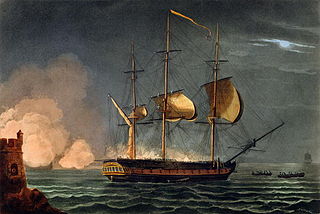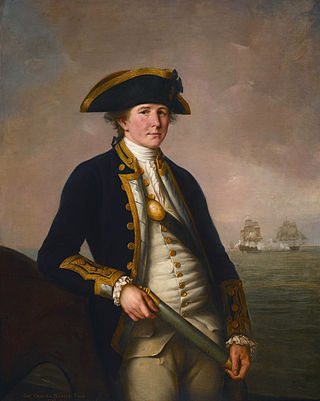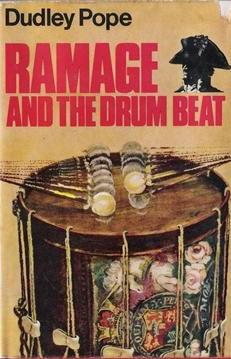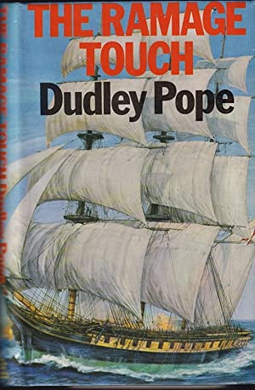Plot
Ramage, recovering from medical leave after the Battle of Cape St Vincent is summoned to the Admiralty by Lord Spencer and given command of a brig, HMS Triton, with orders to take sealed dispatches to the admirals commanding the British fleets off Brest, Cadiz and the West Indies. However, there is just one small problem – HMS Triton is docked at Spithead, where crews of the Royal Navy have mutinied over pay and living conditions. Ramage knows that if he fails in his mission, he will become a convenient political scapegoat for the government.
Although Ramage sympathizes with the aims of the mutineers, he has a mission to perform. He obtains orders to have half of the crew of Triton replaced by men who formerly served under him on the Kathleen, including Southwick and Jackson. He then overcomes the mutiny by cutting the anchor cable as the tide was going out of Spithead harbor, forcing the men to man their posts, or risk drowning when the ship capsized.
Having dealt with the mutiny, partly with the clandestine aid of Jackson, Stafford, Rossi and Maxton, Ramage sets about curing the surgeon, Bowen, of alcoholism. Through a combination of enforced sobriety and an appeal to the man's pride in himself as an expert chess-player (almost the only remaining accomplishment the drunken Bowen can take a genuine pride in), Ramage succeeds in rehabilitating Bowen, who proves to be an excellent doctor once he has quit the drink.
Ramage successfully completes his rendezvous with Admiral Curtis off Brest, and Admiral Jervis of Cadiz, Ramage sets sail across the Atlantic. On the way, he captures La Merlette, a French-owned slave ship before making his rendezvous with Admiral Robinson on HMS Prince of Wales at Barbados.
Ramage is ordered by Admiral Robinson to Grenada, from which numerous merchant ships sailing to nearby Martinique have been mysteriously disappearing en route, presumably due to activity by privateers. Again, Ramage is being set up as a scapegoat, since Admiral Robinson and two of his frigate captains have spent months unsuccessfully searching for these privateers, and can now shift the blame to Ramage should fail at the same mission. At Grenada, Ramage gets off to an uneven start with Colonel Wilson. He then explores the coastlines of all islands between Grenada and Martinique, but is unsuccessful in finding the pirate's lair. On his return to Grenada, Ramage meets Governor Fisher, who turns out to be a pompous, incompetent social climber. However, Ramage accepts Fisher's invitation to a fete, as it will give him an opportunity to meet with many of the local shipowners. At the ball, Ramage falls quickly in love with Claire de Giraud, the extremely competent and beautiful private secretary to the Governor. However, at the ball, one of the shipowners insists that he must sail at once, as his cargo is perishable. Ramage reluctantly agrees, knowing that the ship will most likely be seized before reaching its destination. Only four people know the schedule. When Ramage steps out on the balcony of the governor's mansion for some fresh air, he notices some native drumming, sounding further and further way like the transmission of a message, and the sudden appearance of bonfires on the far coast. He realizes that this is how information on the sailing of ships from Grenada is reaching the pirates, but later realizes that the only person who could have overheard the schedule was Claire de Giraud. When he confronts Claire, he finds that she is the unwilling pawn of Governor Fisher's butler, who is not only a French spy, but is her father. Ramage has his native-Grenadan crewman, Maxton, train Jackson in how to send a false message and lays a trap for the privateers – he and twenty crewmen from the Tritons hide in the hold of a ship provided by Rondin, and allow themselves to be captured by the privateers, with Southwick following just under the horizon in Triton. The plan works, but Ramage finds himself highly outnumbered as he and his crew recapture the ship from the privateers and attempt to fight their way out of their hidden base. With the help of Triton, Ramage finally manages to overcome the privateers and to capture two of their ships. Arriving back at Grenada, he finds a lieutenant waiting with letter from Admiral Robinson reprimanding him for failing to complete his mission, and an angry report from Governor Fisher to the Admiral, both confirming his suspicions that he had been set up as a scapegoat from the start. However, with the capture of the privateers, Ramage finds that he now has the upper hand over his political enemies.

The Spithead and Nore mutinies were two major mutinies by sailors of the Royal Navy in 1797. They were the first in an increasing series of outbreaks of maritime radicalism in the Atlantic World. Despite their temporal proximity, the mutinies differed in character. The Spithead mutiny was a simple, peaceful, successful strike action to address economic grievances, while the Nore mutiny was a more radical action, articulating political ideals as well, which failed.
Dudley Bernard Egerton Pope was a British writer of both nautical fiction and history, most notable for his Lord Ramage series of historical novels. Greatly inspired by C.S. Forester, Pope was one of the most successful authors to explore the genre of nautical fiction, often compared to Patrick O'Brian.
Nicholas, Lord Ramage is a fictional character, the protagonist of a series of sea novels written by Dudley Pope. Ramage was an officer in the Royal Navy during the Napoleonic Wars. He is a contemporary of Horatio Hornblower, but unlike the latter, who never fought in a large fleet battle, Ramage participated in both the Battle of Cape St. Vincent and the Battle of Trafalgar.

HMS Hermione was the lead ship of the Hermione-class, a six-ship class of 32-gun fifth-rate frigates of the Royal Navy. She was launched on 9 September 1782 at Bristol. Hermione was commissioned and then paid off a number of times during the 1780s. She underwent repairs between October 1790 and June 1792, followed by a period spent refitting at Chatham Dockyard until January 1793. She was recommissioned in December 1792 before sailing to the Jamaica in March 1793. Hermione served in the West Indies during the early years of the French Revolutionary Wars, participating in the British attack on Port-au-Prince, where she led a small squadron that accompanied troop transports.

H.M.S. Defiant is a British naval war CinemaScope and Technicolor film from 1962 starring Alec Guinness and Dirk Bogarde. It tells the story of a mutiny aboard the fictitious title ship at around the time of the Spithead mutiny in 1797. It was directed by Lewis Gilbert with a screenplay by Nigel Kneale from Frank Tilsley's novel Mutiny (1958). The film's world premiere occurred at the Odeon Leicester Square in London's West End on 22 February 1962.

Admiral of the Fleet Sir Charles Morice Pole, 1st Baronet GCB was a Royal Navy officer, colonial administrator and politician. As a junior officer he saw action at the siege of Pondicherry in India during the American Revolutionary War. After taking command of the fifth-rate HMS Success he captured and then destroyed the Spanish frigate Santa Catalina in the Strait of Gibraltar in the action of 16 March 1782 later in that War.

HMS Thames was a 32-gun Richmond-class fifth-rate frigate of the Royal Navy built by Henry Adams and launched at Bucklers Hard in 1758. She served in several wars, including for some four years in French service after her capture. She was recaptured in 1796 and was broken up in 1803.

Admiral Sir John Colpoys, was an officer of the British Royal Navy who served in three wars but is most notable for being one of the catalysts of the Spithead Mutiny in 1797 after ordering his marines to fire on a deputation of mutinous sailors. Although this event resulted in his removal from active duty, Colpoys was a capable administrator who remained heavily involved in staff duties ashore during the Napoleonic Wars and was later a Lord of the Admiralty, Knight Companion of the Order of the Bath and Governor of Greenwich Naval Hospital.

Rear-Admiral Sir Charles Cunningham KCH was an officer of the Royal Navy during the late eighteenth and early nineteenth century. He saw action during the American War of Independence and the French Revolutionary and Napoleonic Wars, eventually rising to the rank of rear-admiral.
Hugh Pigot was an officer in the Royal Navy. Through his connections and their patronage, he was able to rise to the rank of captain, despite apparently poor leadership skills and a reputation for brutality. Writing in 1826 William James stated, "...he has been described to us by those who knew him well, as one of the most cruel and oppressive captains belonging to the British navy." While he was captain of HMS Hermione (1782), he eventually provoked his men to mutiny. This mutiny, became the bloodiest in the history of the Royal Navy and left Pigot and nine other officers dead. The Navy hunted down and executed a number of the mutineers and recaptured his ship from the Spanish, to whom the mutineers had turned it over.

Admiral Sir Edward Joseph Hamilton, 1st Baronet KCB was an officer of the Royal Navy, who saw service during French Revolutionary and Napoleonic Wars, eventually rising to the rank of admiral.

Vice-Admiral Thomas Pringle was a British officer of the Royal Navy. He served during the American War of Independence, and the French Revolutionary and Napoleonic Wars.

Ramage and the drum beat, later republished as Ramage and the drumbeat and as Drumbeat is an historical novel by Dudley Pope, set during 1796 and 1797 amongst the naval warfare of the French Revolutionary Wars. It is the second of the Ramage novels, following on from Ramage. During the book, Ramage becomes an integral part of ensuring British readiness for the Battle of Cape St. Vincent (1797).
Vice Admiral Sir Edward Griffith Colpoys KCB was a senior officer of the British Royal Navy during the early nineteenth century. The nephew of a prominent admiral, John Colpoys, Edward Griffith was able to rapidly advance in the Navy, until his involvement at his uncle's side in a violent confrontation aboard his ship HMS London in 1797 left a number of men dead and the Channel Fleet in a state of mutiny. Griffith's career recovered from the events of the Spithead Mutiny and he enjoyed a successful period as a frigate commander off the French coast, later becoming the captain of the ship of the line HMS Dragon during the Trafalgar campaign. Although Dragon did not fight at the climactic Battle of Trafalgar, Griffith was engaged at the preceding Battle of Cape Finisterre in July 1805.
Rear-Admiral James Walker CB, CvTE was an officer of the Royal Navy. He served during the American War of Independence, and the French Revolutionary and Napoleonic Wars.

Rear-Admiral John Bligh CB was an officer in the Royal Navy who served during the American War of Independence and the French Revolutionary and Napoleonic Wars.

HMS Hound was a brig-sloop of the Royal Navy. She had a short history. After her launch in 1796 she captured two privateers and destroyed a third before she was lost in 1800.

Governor Ramage R.N. is an historical novel by Dudley Pope, set during the French Revolutionary Wars. It is the fourth of the Ramage novels, following on from Ramage and the Freebooters.

Ramage's Signal, is an historical novel by Dudley Pope, set during the French Revolutionary Wars. It is the eleventh of the Ramage novels, following on from The Ramage Touch.

The Ramage Touch, is an historical novel by Dudley Pope, set during the French Revolutionary Wars. It is the tenth of the Ramage novels, following on from Ramage and the Rebels.















